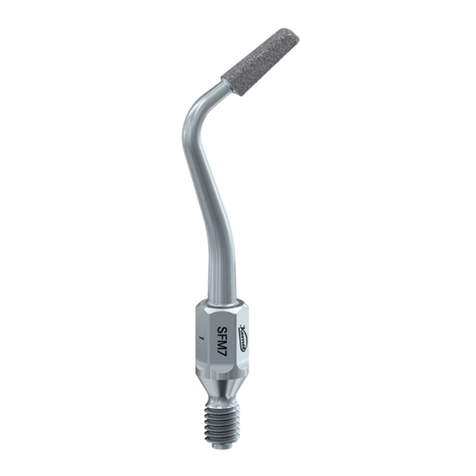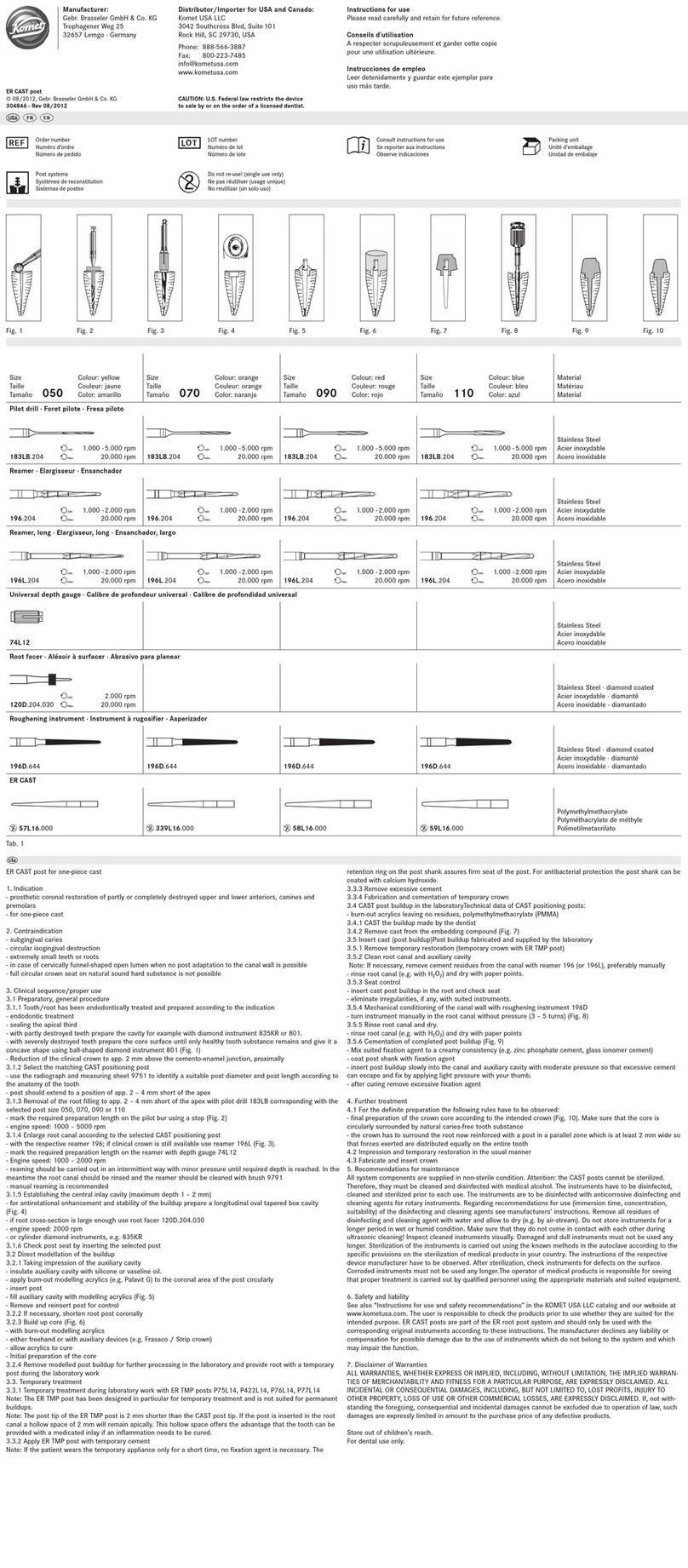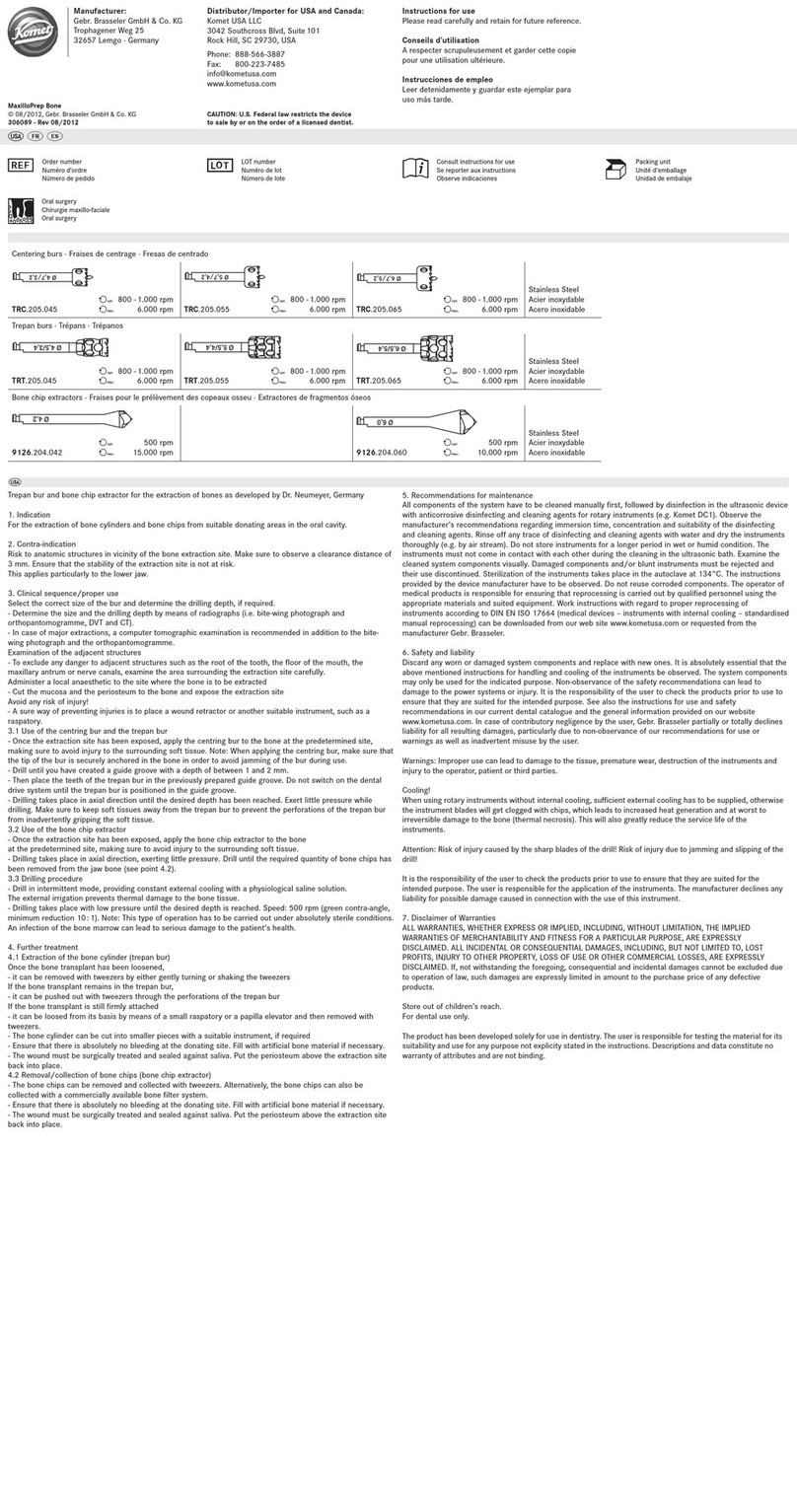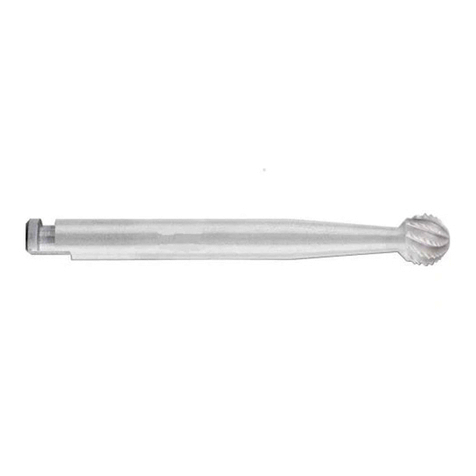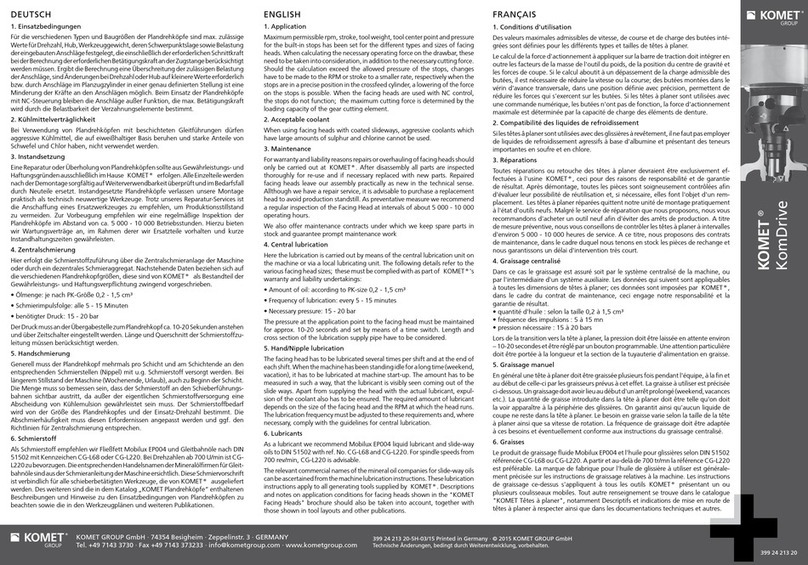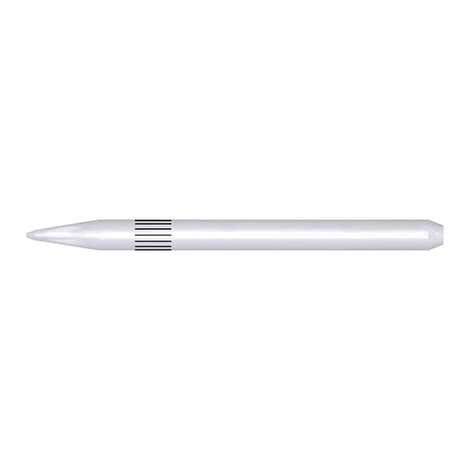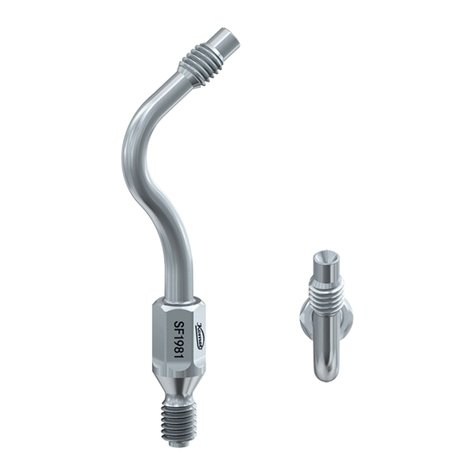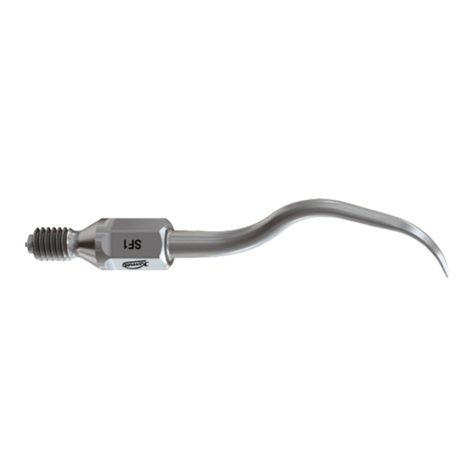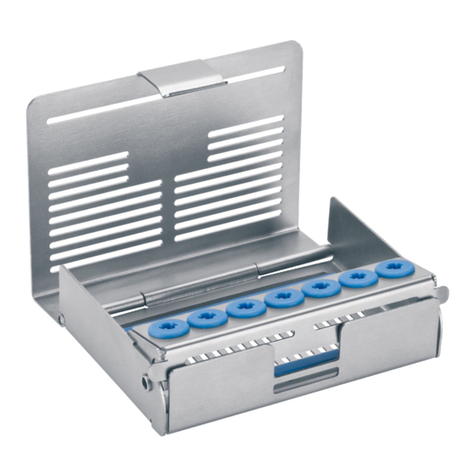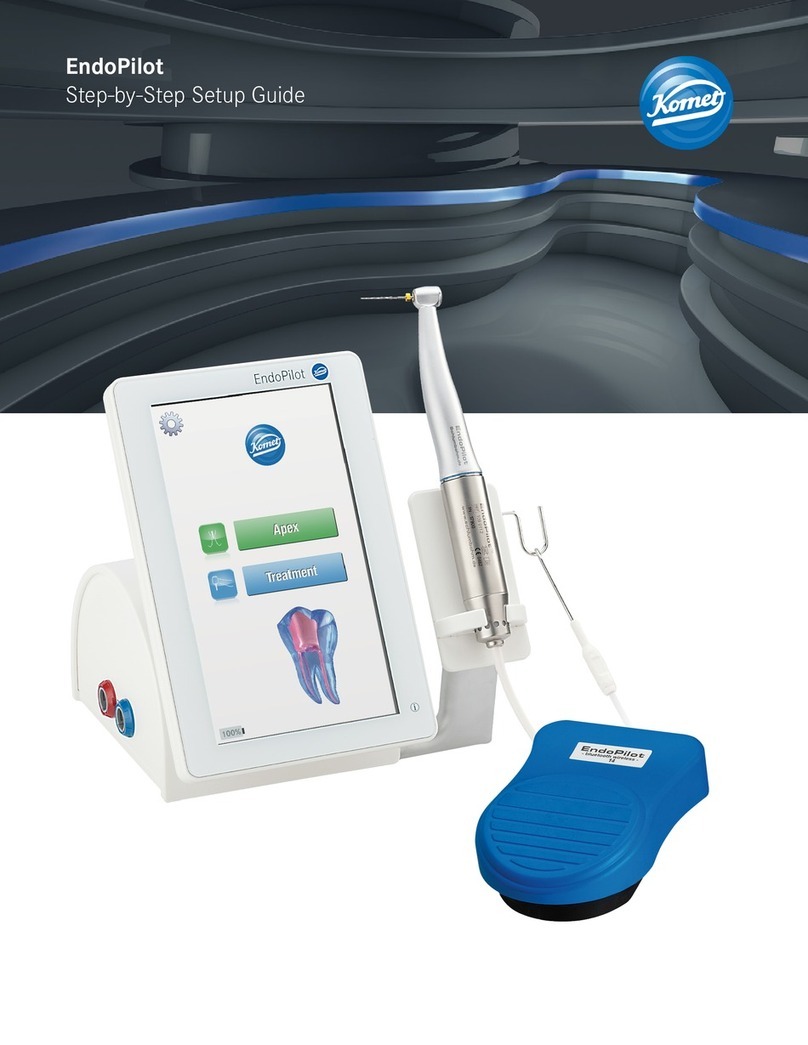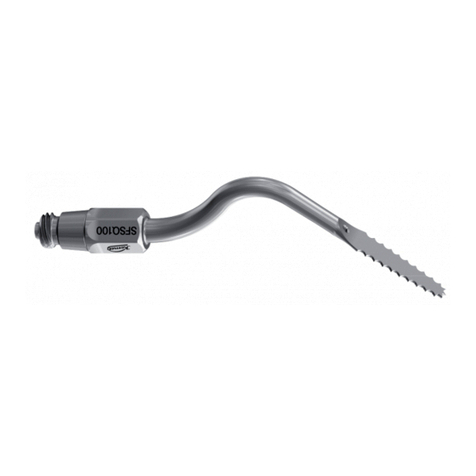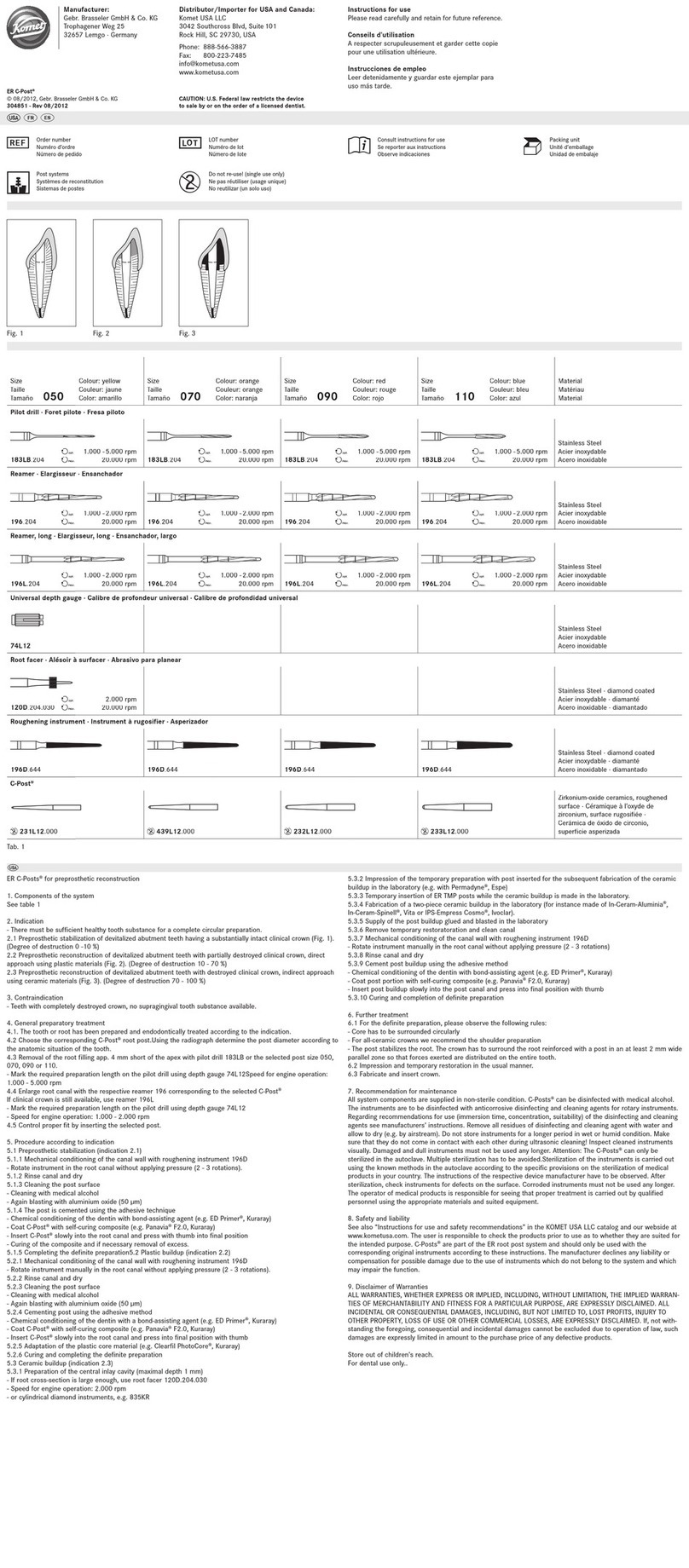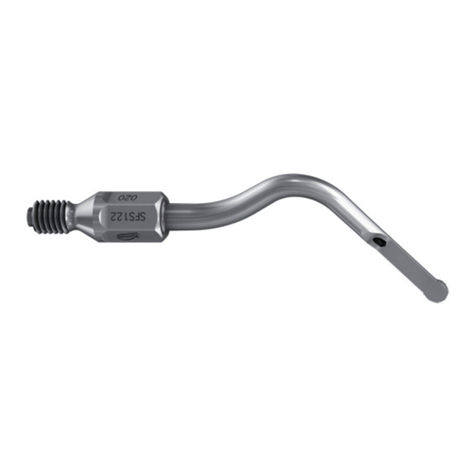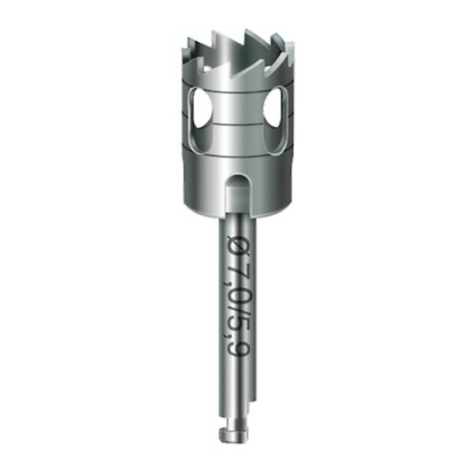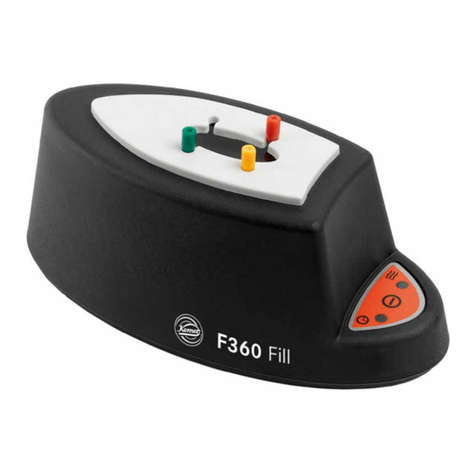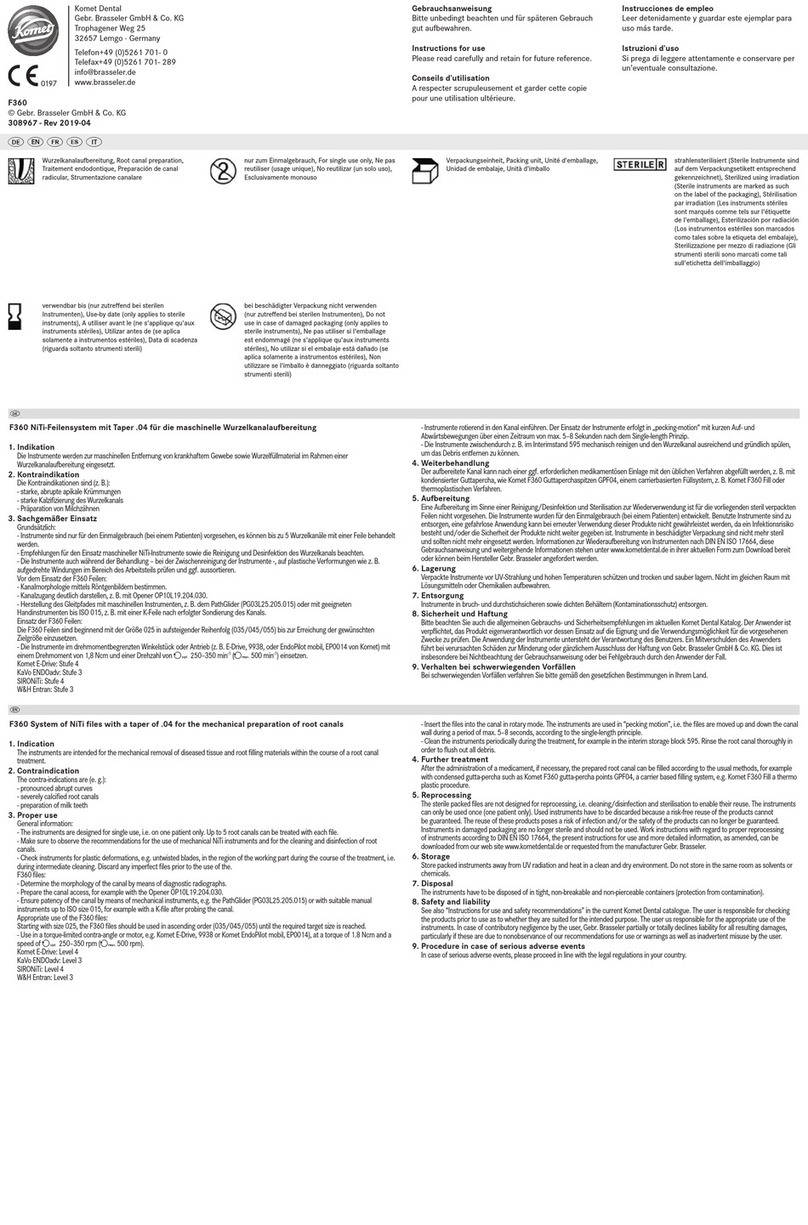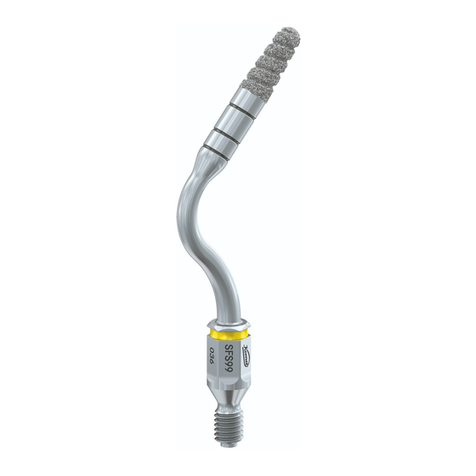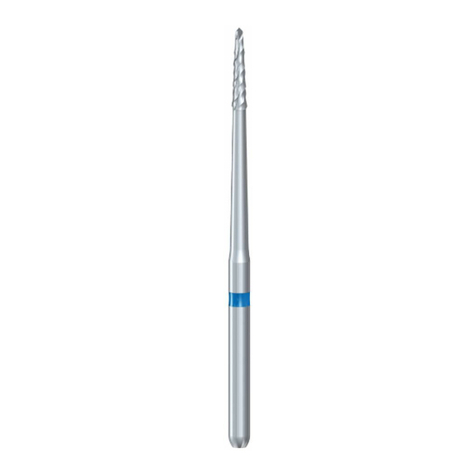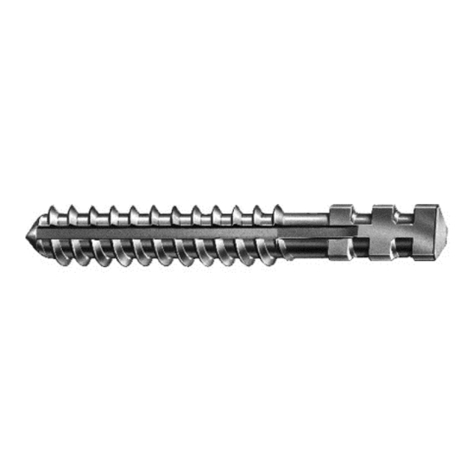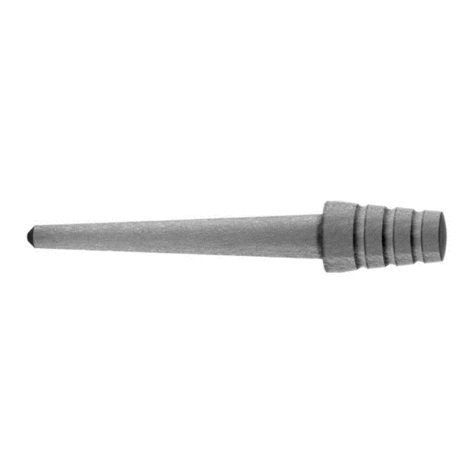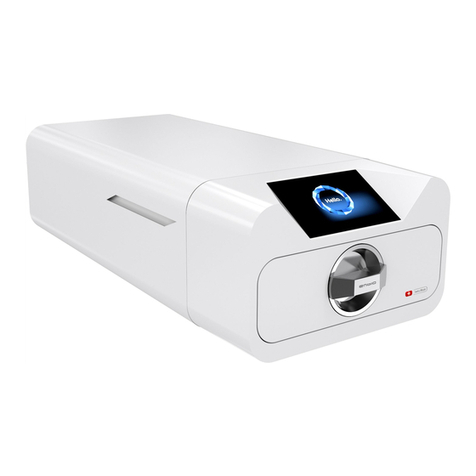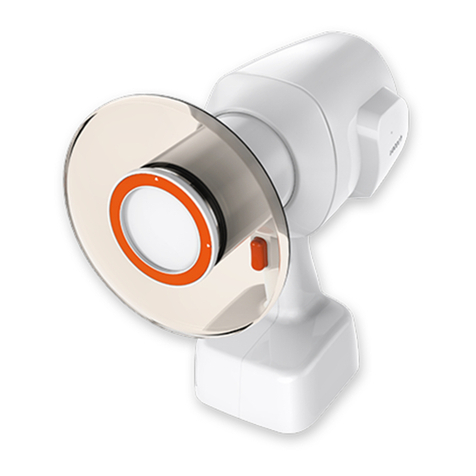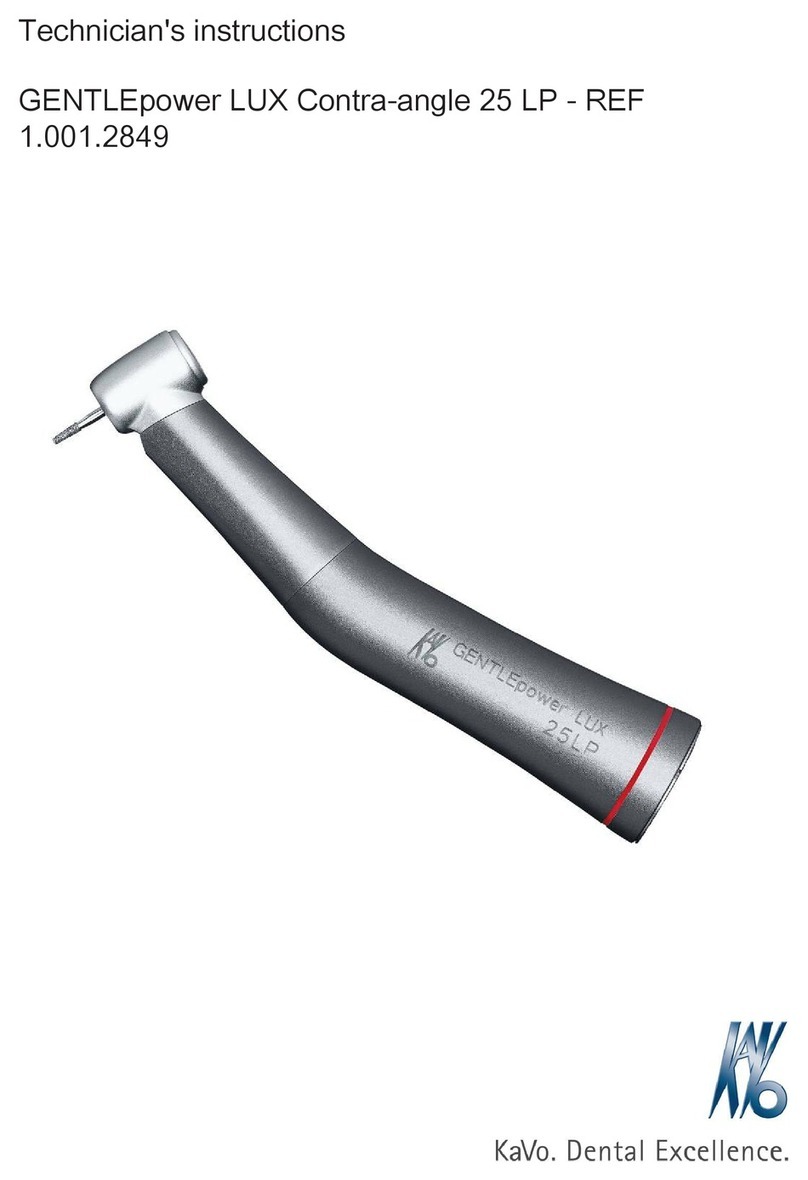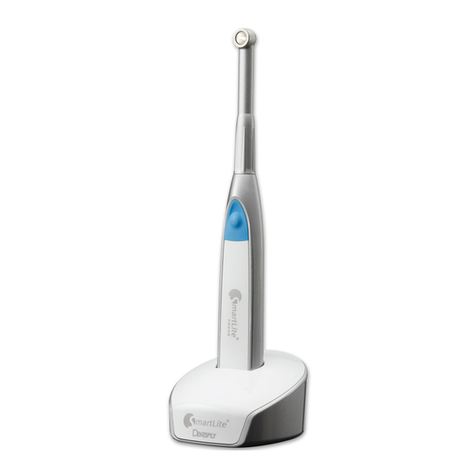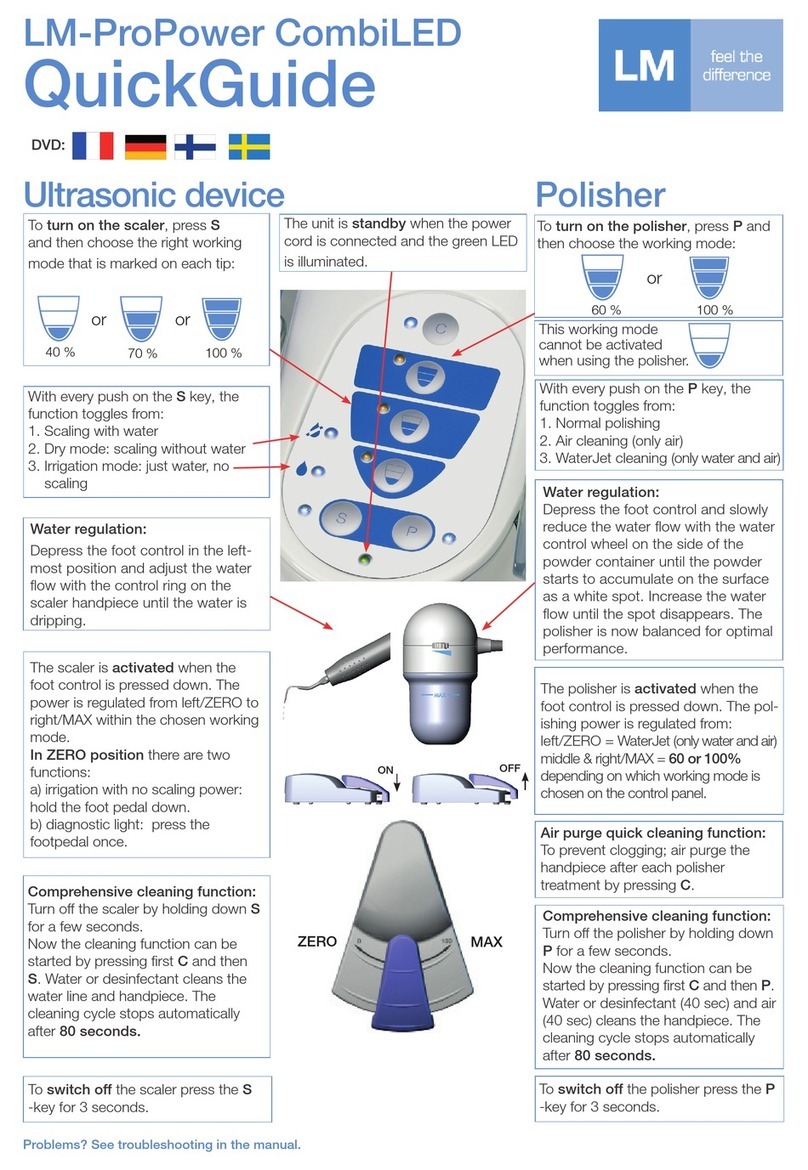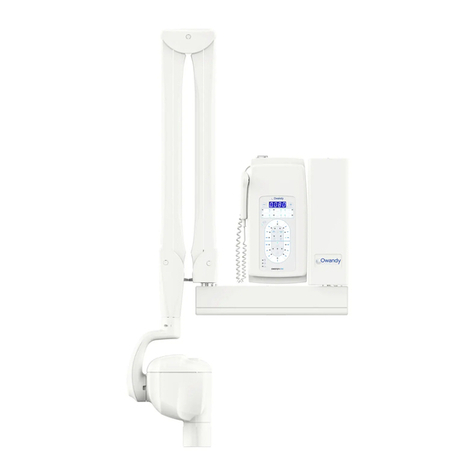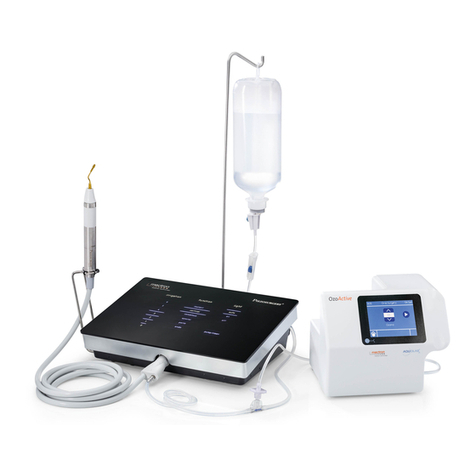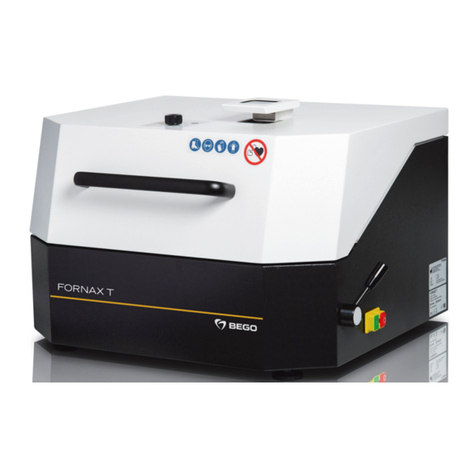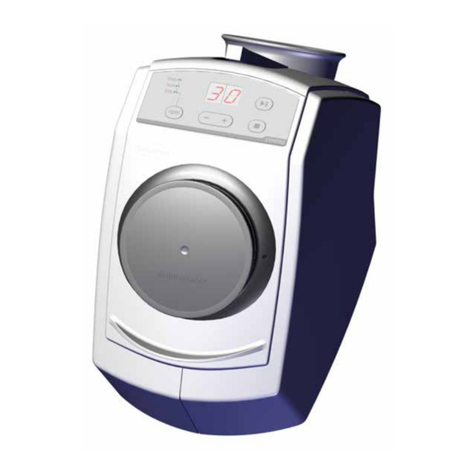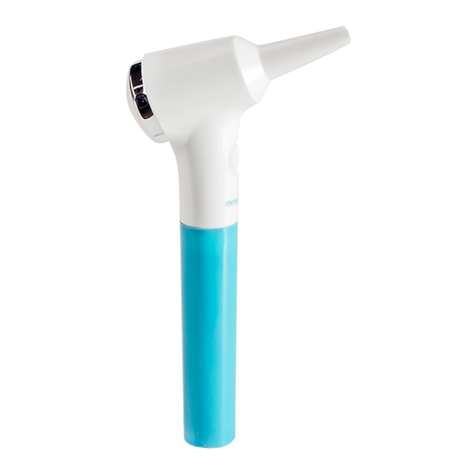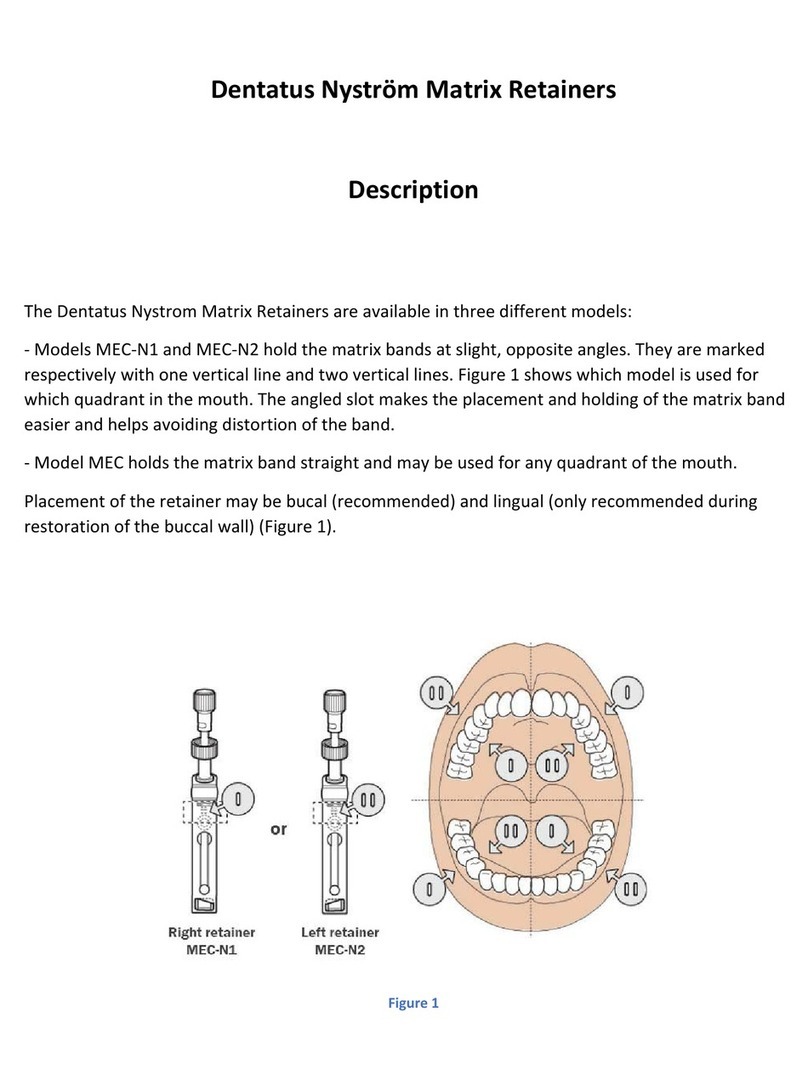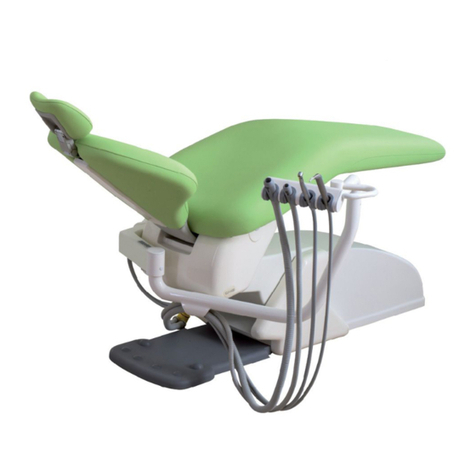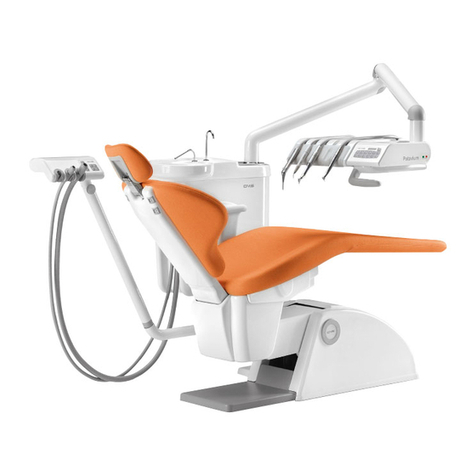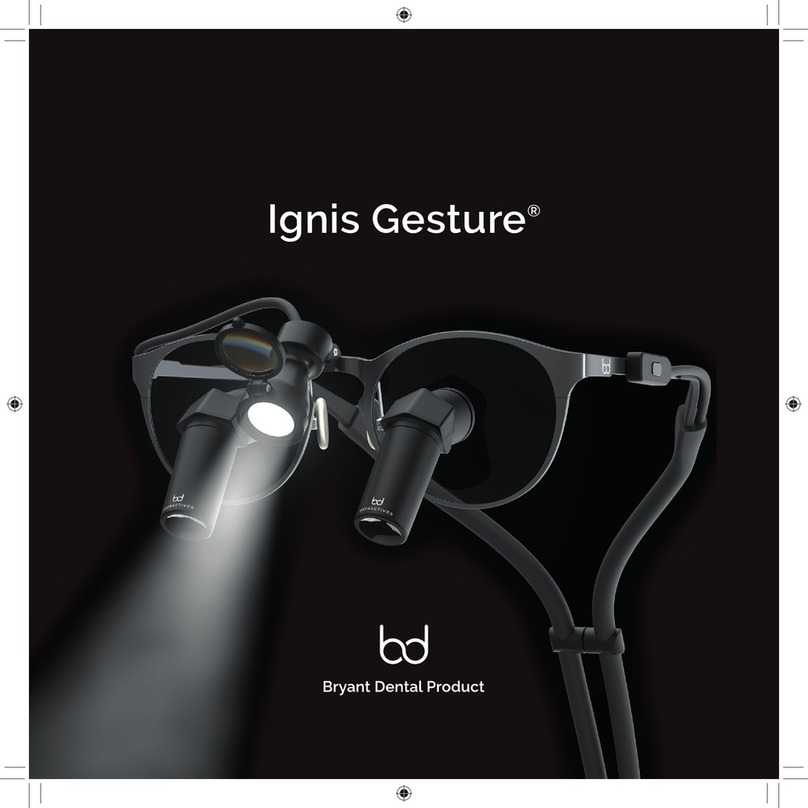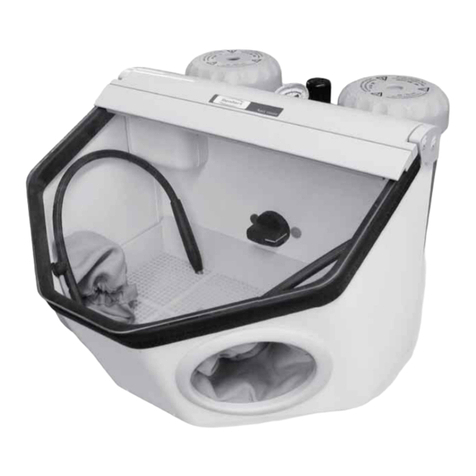
ê
Fraise en carbure de Tungstène combinée, Fig. H254E, H254LE, H255E, H162SL, H162SXL
1. Indication
- Instruments combinés peu invasifs pour la préparation conservatrice des tissus osseux et de la substance
dentaire dure
- Retrait des dents de sagesse persistantes
- Résection apicale
L'instrument est utilisé pour la préparation conservatrice de l'os ou d'un couvercle osseux qui peut être reposé
suite au retrait d'une dent de sagesse persistante ou à la résection apicale, ou p.ex. pour le retrait définitif de la
substance dentaire environnante. Grâce à sa capacité de coupe très efficace, cet instrument est aussi approprié
pour couper de la substance dentaire dure et spécialement des racines.
2. Contre-indications
- Des préparations où l'instrument peut servir de levier (p.ex. lors du relâchement et du retrait de l'os ou de la
dent de sagesse)
- Ne pas approprié pour couper des tenons radiculaires
- Refroidissement externe insuffisant (moins de 50 ml/min.)
3. Utilisation appropriée
Lors du retrait des dents de sagesse persistantes ou de la résection apicale, de la préparation des surfaces
osseuses ou de la section de l'os.
- exposer d'abord le maxillaire selon les procédés généralement connus
- utiliser l'instrument combiné avec refroidissement externe abondant (mini. 50 ml/min.) et contourner le greffon
osseux selon la forme et l'endroit ou enlever l'os environnant. Lors d'une préparation axiale guider l'instrument
avec des mouvements circulaires pour éviter que l'instrument ne se coince. Le refroidissement externe
empêche, d'une part, le réchauffement excessif du tissu osseux, d'autre part il est important pour l'évacuation
ou le rinçage des copeaux d'os.
- la préparation s'effectue avec peu de pression (≤ 2N) jusqu'à la profondeur désirée. Veiller à ce que les
surfaces de coupe soient suffisamment couvertes de réfrigérant.
- séparer la dent ou la racine avec l'instrument combiné (sous refroidissement abondant, mini. 50 ml/min.) et
enlever les fragments à l'aide d'une tenaille ou pince.
- si possible, reposer le greffon osseux en respectant les procédés connus en matière de traitement des
blessures et refermer ensuite la muqueuse.
Note : Ne pas effectuer des mouvements de levier (risque d'accident) ! Les fraises avec tige 314/316 doivent
être utilisées sur micromoteur (contre-angle bague rouge) et pas sur turbine.
4. Recommandations d'entretien
Tous les instruments livrés non stériles doivent être nettoyés, désinfectés et stérilisés avant la toute première
utilisation.
Les instruments doivent être désinfectés avec des agents de désinfection et de nettoyage anticorrosifs pour des
instruments rotatifs (p.ex. Komet DC1) après chaque utilisation. Respecter les indications du fabricant des
produits de désinfection et de nettoyage relative aux temps de trempage, aux dosages et à la compatibilité du
matériau. Stériliser les instruments comme à l'accoutumé. L’utilisateur des produits médicaux est le responsable
et il doit veiller à ce que le traitement des produits s’effectue par le personnel qualifié, avec les matériaux
appropriés et l’équipe correspondant, conformément aux recommandations de la Commission pour l’hygiène
hospitalière et la prévention des infections de l’institut Robert Koch. Les fiches d’instructions pour la préparation
des instruments selon DIN EN ISO 17664 peuvent être téléchargées au site www.kometdental.de ou bien
demandées du fabricant Gebr. Brasseler.
5. Sécurité et responsabilité
Eliminer immédiatement les instruments usés ou endommagés et les remplacer par des instruments neufs.
Observer les indications à l'égard du maintien, du refroidissement et de la pression de contact. Les instruments
doivent uniquement être utilisé selon l'application spécifique. Le non-respect de ces conseils de sécurité peut
endommager la pièce-à-main ou provoquer des lésions. Veuillez aussi observer les conseils d'utilisation et les
recommandations de sécurité mentionnés dans notre catalogue actuel ou sur notre site web www.kometdental.de.
Obligation pour l'utilisateur de s'assurer que les produits sont adaptés à chaque cas. Une négligence de la part
l’utilisateur entraînant des dommages, spécialement si ceux-ci sont causés par le non-respect de nos
recommandations d’utilisation ou avertissements ou par un mauvais usage involontaire, conduit à la réduction ou
à l’exclusion totale de la responsabilité de la part de Gebr. Brasseler.
í
Fresa de carburo de tungsteno, Fig. H254E, H254LE, H255E, H162SL, H162SXL
1. Indicación
- Instrumento de combinación mínimamente invasivo para la preparación conservadora del tejido óseo y de la
sustancia dura del diente.
- Separación de muelas de juicio retenidas
- Apicectomía
El instrumento es utilizado para la preparación conservadora de hueso o de la tapa ósea que debe ser repuesta,
por ejemplo, después de la extracción de muelas de juicio retenidas o de una apicectomía, siendo apropiado
además para la remoción definitiva del tejido óseo circunferencial. Debido a su alta eficacia de corte, el
instrumento sirve para cortar sustancia dura del diente y - especialmente - las raíces.
2. Contraindicaciones
- Tratamientos que requieran el uso del instrumento como palanca (como por ejemplo para aflojar o remover
huesos cortados o muelas de juicio).
- Inadecuado para corte de pernos radiculares
- Refrigeración externa insuficiente (menos de 50 ml/min.)
3. Utilización apropiada
Para la extracción de muelas de juicio retenidas, apicectomías, tratamiento de superficies óseas y cortes en
hueso
- Exposición del hueso del maxilar o de la mandíbula según procedimientos normales y conocidos.
- Preparación del contorno del implante de hueso por medio del instrumento de combinación con suficiente
refrigeración externa (mín. 50 ml/min.), teniendo en cuenta su forma y su posición o para remoción del hueso
circundante. Para la preparación axial, realizar movimientos circulares para impedir que el instrumente se
tranque. La refrigeración externa evita por un lado el calentamiento excesivo del hueso y por otro ayuda en la
evacuación de los fragmentos óseos.
- La preparación se efectúa con presión reducida (≤2N) hasta lograr la profundidad deseada. Cuidar que la
superficie de corte esté cubierta con suficiente cantidad de refrigerante.
- Utilizar aspiración para remover los residuos óseos y/o remover el transplante de hueso flojo mediante unas
pinzas.
- Separar el diente o la raíz con el instrumento de combinación (con suficiente refrigerante externo, mín.
50 ml/min.) y remover los fragmentos, trozo por trozo, por ejemplo con fórceps o pinzas.
- Tratar la herida según los procedimientos normales y conocidos y - de ser la indicación adecuada - reponer el
transplante de hueso y finalmente sellar la mucosa.
Nota:
Evitar tratamientos que requieran el uso de instrumentos como palanca (riesgo de accidente). Instrumentos con
mango 314/316 han sido diseñados para uso en el micromotor (contra-ángulo rojo) y no en la turbina.
4. Recomendaciones para el mantenimiento
Los instrumentos entregados sin esterilizar deben ser desinfectados, limpiados y esterilizados antes de su
primer uso.
Los instrumentos deben ser desinfectados con desinfectantes y detergentes con protección anticorrosiva para
instrumento rotatorios (por ejemplo con Komet DC1) desqués de cada uso. Las recomendaciones de empleo
(tiempo de inmersión, concentración, propiedades) de los agentes de desinfección o limpieza se encuentran
en las instrucciones del fabricante de estos agentes. La esterilización de los instrumentos se efectúa por los
procedimientos conocidos. El operador de productos médicos es el responsable de ver que el tratamiento
sea efectuado por el personal calificado usando los materiales apropiados y el equipo correspondiente,
conformemente a las recomendaciones de la Comisión para la Higiene Hospitalaria y la Prevención de
Infecciones del instituto Robert Koch. Las instrucciones de trabajo para la preparación de instrumentos según
DIN EN ISO 17664 pueden ser bajadas de www.kometdental.de o pedidas del fabricante Gebr. Brasseler.
5. Seguridad y responsabilidad
Eliminar inmediatamente los instrumentos desgastados o dañados y reemplazar por instrumentos nuevos. Es
absolutamente necesario observar las instrucciones para el correcto mantenimiento, la refrigeración y la presión
de contacto arriba mencionadas. Los instrumentos sólo deben utilizarse para el uso previsto e indicado. En caso
de no respetar estas instrucciones de seguridad, existe riesgo de daños a la pieza de mano o de accidentes. Por
favor, observe las instrucciones de empleo y las recomendaciones de seguridad que se encuentran en el último
catálogo dental de Komet. El operador tiene la obligación de examinar los productos. Es el responsable de ver -
antes de utilizarlos - que su estado sea el apropiado para el uso provisto. Una negligencia del operador generará,
en caso de daños provocados por parte del mismo, una reducción o la exclusión completa de responsabilidades
por parte de Gebr. Brasseler. Este será especialmente el caso si no se observaron nuestras recomendaciones de
uso o las advertencias, o en caso de uso incorrecto involuntario.
ë
Strumento in carburo di tungsteno H254E, H254LE, H255E, H162SL, H162SXL
1. Indicazioni
- Strumenti combinati per interventi ad invasione minima e per la preparazione del tessuto osseo e della
sostanza dura del dente
- Per l'estrazione di denti del giudizio retinati
- Per la resezione delle punte della radice
Lo strumento viene impiegato per la preparazione ad invasione minima del tessuto osseo o della copertura ossea
che può essere riposta, ad esempio, in seguito all'estrazione di denti del giudizio retinati o nella resezione delle
punte della radice, oppure per la rimozione definitiva del tessuto osseo circostante. Grazie alla sua alta efficienza
di taglio, con lo strumento si può scindere in generale anche la sostanza dura del dente, in particolare radici.
2. Controindicazioni
- Trattamenti in cui si impiega lo strumento con funzione di leva (ad esempio per smuovere e rimuovere il tessuto
osseo preparato o il dente del giudizio)
- Asportazione di schegge di perni di radice
- Mancanza di un raffreddamento esterno in quantità sufficiente (sotto 50 ml/min.)
3. Impiego appropriato
Per l'estrazione di denti del giudizio retinati o per la resezione delle punte di radici, per il trattamento di superfici
ossee o per il taglio dell'osso
- Dapprima scoprire l'osso della mascella o della mandibola nel quadro dei noti procedimenti generali
- Con sufficiente raffreddamento esterno (minimo 50 ml/min.), mediante lo strumento combinato preparare
il contorno del trapianto osseo a seconda della forma e della posizione o asportare il tessuto osseo circos-
tante. Nella preparazione assiale condurre lo strumento con movimenti circolari per impedirne l'incastro. Il
raffreddamento esterno impedisce da un lato un surriscaldamento del tessuto osseo e dall'altro lato assicura
l'asportazione delle schegge ossee.
- La preparazione avviene a bassa pressione (≤ 2N) fino alla profondità desiderata. Occorre prestare attenzione
al fatto che la superficie di taglio sia circondata da una quantità sufficiente di liquido di raffreddamento.
- Separare il dente o la radice con lo strumento combinato; sufficiente raffreddamento esterno, minimo
50 ml/min.) e toglierlo con una tenaglia o una pinzetta.
- Nel quadro del noto procedimento generale relativo alla medicazione della ferita, se indicato riporre il trapianto
osseo e quindi sigillare la mucosa.
Indicazione: Assicurarsi che gli strumenti non vengano utilizzati come leva (pericolo di incidente). Gli strumenti
con gambo 314/316 devono essere utilizzati su micromotore anello rosso e non su turbina.
4. Avvertenze per la manutenzione
Gli strumenti forniti non sterili devono essere preparati prima di procedere al primo utilizzo.
Gli strumenti devono essere disinfettati con disinfettante e detergente per strumenti rotanti con anticorrosivo
(ad esempio con Komet DC1) dopo di ogni uso. Per le indicazioni sull'impiego (durata, concentrazione, idoneità)
di disinfettanti e detergenti consultare le istruzioni del produttore. Sterilizzare gli strumenti nel modo conven-
zionale. Il detentore di prodotti medicali è tenuto ad assicurare che la preparazione venga effettuata con
l’apposita dotazione, gli appositi prodotti, nonché realizzata da personale qualificato, conformemente alle
raccomandazioni della Commissione per l’igiene negli ospedali e la prevenzione delle infezioni dall’Istituto Robert
Koch. Le istruzioni di lavoro per la preparazione degli strumenti secondo DIN EN ISO 17664 possono essere
scaricate dal sito internet www.kometdental.de o richieste dal produttore Gebr. Brasseler.
5. Sicurezza e responsabilità
Strumenti usurati o danneggiati vanno scartati subito e sostituiti da strumenti nuovi. Le indicazioni sulla
manipolazione, il raffreddamento e la pressione da esercitare devono essere rispettate in qualsiasi caso.
Gli strumenti devono essere impiegati solo per l'utilizzo previsto. In caso di inosservanza di queste norme
di sicurezza si possono verificare danni del sistema di azionamento o lesioni. Si prega di osservare anche le
raccomandazioni generali sull'uso e sulla sicurezza riportate nel catalogo attuale Komet o sul nostro sito web
www.kometdental.de. Prima del loro impiego, l'utente ha l'obbligo di controllare sotto la propria responsabilità
l'idoneità e le possibilità di utilizzo per lo scopo previsto dei prodotti. Un concorso di colpa dell’utilizzatore
comporta, in presenza di danni causati da questi, la riduzione o la totale esclusione della responsabilità della
Gebr. Brasseler. Questo vale in particolare nel caso di inosservanza delle istruzioni per l’uso o degli avvisi o
ancora di uso sbagliato involontario da parte dell’utilizzatore.
